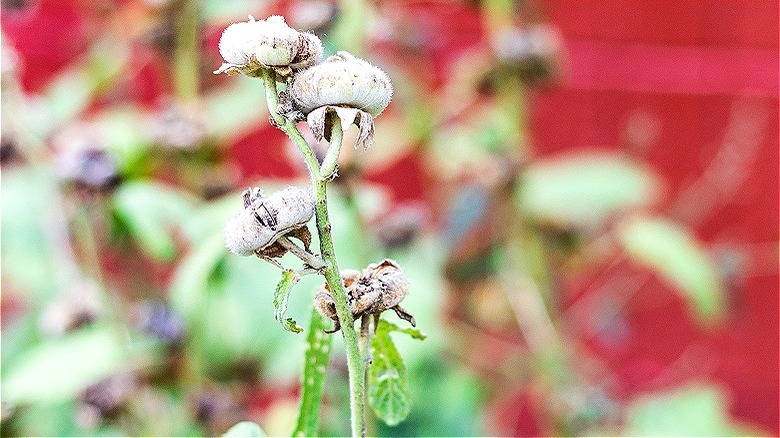The Ultimate Guide To Deadheading Hollyhocks In The Garden
Hollyhocks! The name conjures up images of towering plants striving to kiss the sun — an ambitious feat they admirably reach up at heights up to 9 feet. Quite the garden's runway models, they're celebrities of the landscaping world, parading their elegance between June and August. Wrapped in sepals with no visible stalks, their blooms generously open into stunning cup-like marvels. And we can't forget the fashion parade of colors, a lineup boasting pure whites, pretty pinks, ravishing reds, youthful yellows, bodacious blues, or bold blacks. The large, coarse, palmate-shaped leaves? That's just their version of a standout accessory. Now, onto our main event: deadheading hollyhocks. It's less a "Game of Thrones" plot twist and more of a gentle gardening practice — removing wilted or dead flower heads from the botanical VIPs.
But do hollyhocks need to be deadheaded? Well, not necessarily. But if you want your garden to be the neighborhood sensation, sporting blooms that last throughout the season into late summer, clearing away the lifeless blooms is highly recommended. Deadheading hollyhocks, as it turns out, is a bit of a neat freak's dream — it keeps your towering beauties polished, contributing to an overall smart, manicured appearance for your garden. But as you wield the metaphorical stylist combs (or pruning shears) to your hollyhock's showy headdresses and control the fallen leaf litter, you might also deter self-seeding. Whether that's good or bad is a matter of your personal goals.
When to deadhead hollyhocks
You might assume there's a set alarm for deadheading hollyhocks, but alas, life isn't straightforward — and neither is gardening. In essence, deadheading hollyhocks becomes necessary as soon as the flowers lose their youthful allure. That reignites the plant's energy, urging them to keep the blooming jamboree going for as long as possible. You'd be surprised to know hollyhocks have a reputation for being a floral Phoenix, capable of rising from the ashes of their earlier bloom for a second gig in late summer or early fall. But how often should you deadhead hollyhocks? Though they won't slide into your DMs with a wilted bloom emoticon, these beauties communicate loudest through wilted blooms. Keep a keen eye out and act swiftly to prevent your hollyhocks from morphing into a summer catastrophe.
But say you want an encore performance from your hollyhocks, desiring they multiply naturally (hello, self-seeding). In that case, pause on deadheading until the flowers take on a brownish hue and do a seed drop. But how do you know that the hollyhock seeds have dropped? Inspect the brown pods post-flowering-dropping; they could be holding a cluster of black seeds. But sometimes, they may just be empty. If the pod is dry, brown, and bursting with seeds, they're shrieking for some help. Simply remove the pods and disperse the seeds over the ground. Or if you're feeling a wave of gardening guerilla tactics, save the seeds for a surprise planting party elsewhere later.
How to deadhead hollyhocks
Unlike prima-donna species that stage a single bloom spectacle per stalk, hollyhocks are multitaskers. Their flower stalks play host to multiple heads that unveil their glamour at their own pace. Pinching off the wilting flower buds starting from the bottom of the stalk, all while awaiting development from the upper echelons, fosters their visual appeal. Now, let's move to fostering a second round of blooming. Once you deem the majority of the blooms — roughly three-quarters, to be exact — at the top have played their part, swoop in with your pruning shears or trusty scissors and snip right at the base.
Now, here's a plot twist. Those pruned hollyhock parts aren't just garden waste — they are a gourmet's wildcard. Surprising, right? The flower and stems provide a unique flavor dimension to salads and soups, and if they come off as too rough, mellowing them down with hot water to a soothing tea does the trick. A word of caution, though: Rust disease is a deal-breaker. If you notice any brown or yellow spots on the leaf undersides, it's a strict no-consume zone. Your careful grooming rewards you with new flower stalks rising with valor for their second act. They might not aspire to the lofty heights of their ancestors, but their vibrant presence sure steals the show. Remember, Mother Nature will still switch things to autopilot, marking the start of self-seeding if you don't deadhead your plants during their second blooming cycle.


